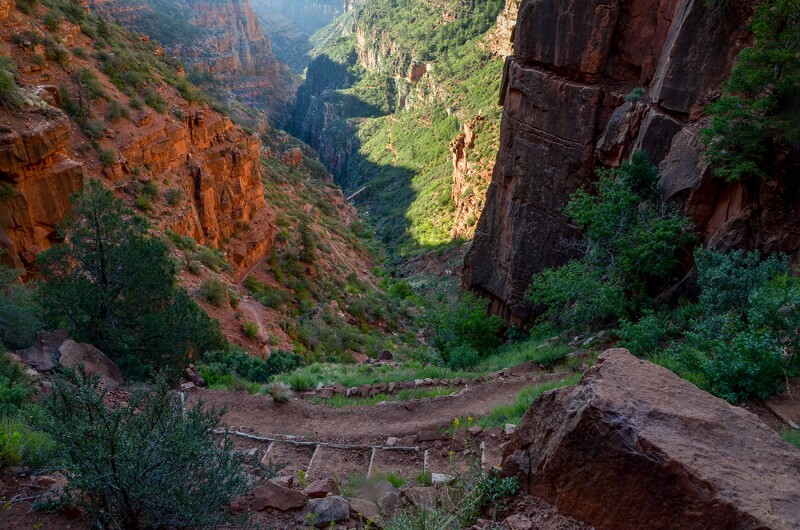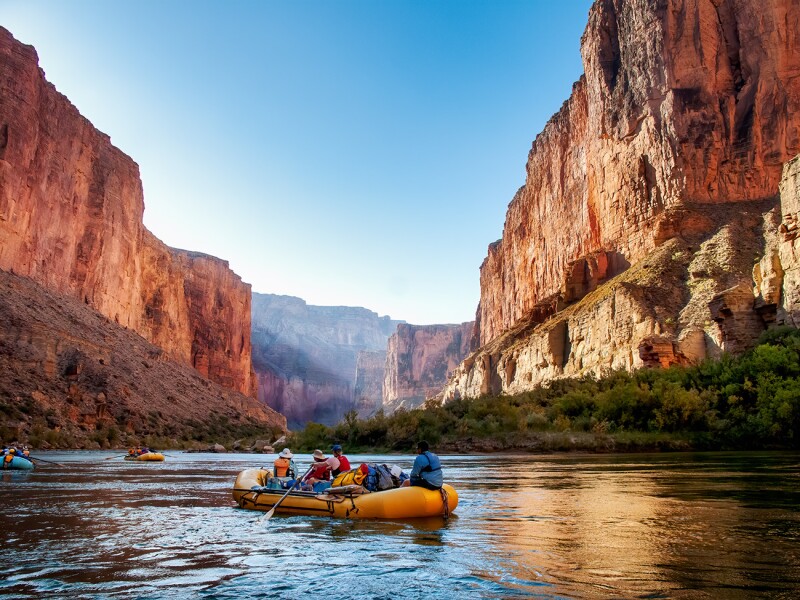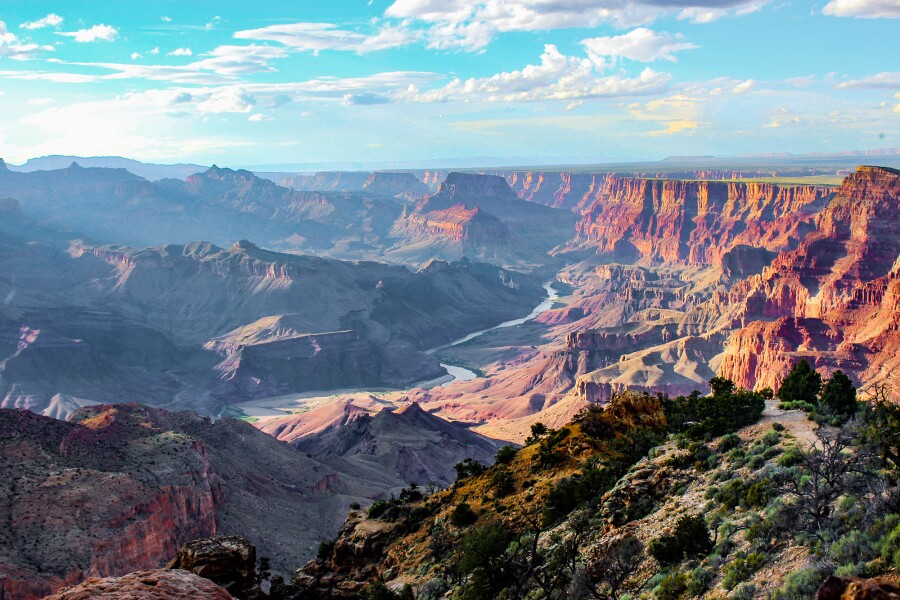At 278 river miles long and 18 miles across at its widest point, the Grand Canyon is big. So big, in fact, that you could spend a week exploring and barely see one rim (let alone the depths of the canyon). To make it all less overwhelming, we’ve put together the ultimate guide to getting the most out of your first visit, whether you have a day or a week.
Let’s start with the basics: 5 to 6 million years ago, the Colorado River began carving the Grand Canyon out of the Colorado Plateau. Today, the river flows southwest through the Canyon, before reaching Lake Mead on the Arizona-Nevada border. To orient yourself, think of the landscape in terms of the South, North, West, and East Rims, keeping in mind that there’s no way to cross the canyon by car—you have to drive all the way around.
The South Rim is the most popular area of the Grand Canyon, with the greatest number of viewpoints, visitor services, and hotels. More than 1,000 feet higher, the North Rim gets a good deal of snow and closes down from October to May. (Backcountry camping is still available, though a permit is required.) It’s about a 212-mile, four-and-a-half-hour drive from the South Rim, so it’s perhaps best reserved for a separate or extended visit.

Fight vertigo on the Grand Canyon Skywalk, a glass-bottomed bridge 4,000 feet above the canyon.
Courtesy of Arizona Office of Tourism
The West Rim, known as Grand Canyon West, sits on the tribal lands of the Hualapai and includes the Grand Canyon Skywalk, a horseshoe-shaped cantilever bridge with a glass bottom, perfect for conquering that fear of heights. Finally, the East Rim, which is lower in elevation at 4,200 feet, is part of the Navajo Nation and features numerous smaller canyons carved by the Little Colorado River.
Before we dive in deeper, note that not all of the Grand Canyon lies within Grand Canyon National Park. There are 11 federally recognized tribes associated with the canyon, and the Hualapai, Navajo, and Havasupai reservations border the park, so pay attention to their rules and policies. Also keep in mind that the season and weather will play a role in your Grand Canyon planning, with roads, viewpoints, and services subject to closure.
If you only have one day . . .
Most people aiming to see the canyon in one day will prioritize the South Rim, where it’s possible to see and do the most in the least amount of time. You’ll have your sightseeing cut out for you, though, so use the following plan to check all the most important boxes in a short visit.
Start with sunrise
Waking up before dawn will seem well worth it when the first rays make the canyon walls glow gold. Mather Point is a go-to spot to watch sunrises and sunsets, but you can’t go wrong anywhere along the Rim Trail.
See the main South Rim sights
The primary attractions sit in a loop along the rim, connected by a hop-on, hop-off shuttle. If you get the early-morning start suggested above, you can realistically see them all in one day, though most people tend to skip a museum or two.
Grand Canyon Visitor Center: Watch an introductory movie, check out the relief map, sit in on a park ranger lecture, and catch the rim shuttle.

The El Tovar Hotel is widely considered the crown jewel of the National Park lodges.
Courtesy of El Tovar Hotel
El Tovar Hotel: Peek into the lobby of one of the grandest of the historic National Park lodges.
Hopi House: Tour this 1905 building designed by Mary Colter—one of the first female architects in the United States—to resemble a Pueblo village. It now showcases Navajo and other American Indian arts and crafts.
Kolb Studio: Visit the early 20th-century home and studio of pioneering photographers Emery and Ellsworth Kolb to see pictures and antique photo equipment.
Verkamp’s Visitor Center: Shop for souvenirs and get your questions answered in this souvenir shop dating to 1906.
Yavapai Geology Museum: Learn about the forces that formed the canyon and take in the views at Yavapai Point.
Walk the Trail of Time
A section of the Rim Trail signed with detailed explanations of geological history, the short but worthy Trail of Time helps make sense of the colorful layers that give the canyon walls their candy-stripe appearance.

Located along the South Rim on Hermit Road, Hopi Point is the perfect place to watch the sunset.
Photo by Francisco Blanco/Shutterstock
Explore Hermits Rest and Hopi Point
West of Grand Canyon Village, a series of overlooks along Hermit Road offer some of the canyon’s most beloved views. For the best experience, follow the crowds to Hermits Rest at sunset and watch the rays turn the canyon crimson. When the road is closed to private cars from March 1 through November 30, shuttle buses ferry visitors to nine lookouts, including Mohave and Pima Points and the Abyss—so named because it’s a sheer vertical drop of 3,000 feet.
Drive to Desert View
Alternatively, you could watch the sunset at Desert View. After stopping at a few viewpoints along Hermit Road, take the scenic, 23-mile Desert View Drive, which passes the stunning Grandview Point, Moran Point, and Navajo Point. The route finishes at the Desert View Watchtower, designed by Mary Colter in 1932. From the top, you can see for well over 100 miles on a clear day.
If you have three days . . .
More time means more opportunities to take in the canyon’s variegated walls and gravity-defying formations from different angles and directions.
Hike into the canyon
It’s hard to fully appreciate the depth of the Grand Canyon without going to the bottom and looking up. For campers, the most popular route down is the Bright Angel Trail, which is about five miles one way to Havasupai Gardens, and nine miles to Bright Angel campgrounds. Don’t delay in applying for a backcountry permit because sites fill up fast.
If you’d rather make it a day trip, hike part of the way down to one of the rest houses at one and a half or three miles, then head back up (remember: coming up takes longer than going down) with a far greater appreciation for the canyon’s geological marvels.
Head north
More rugged and less crowded—it typically sees a tenth of all park visitors—the North Rim is cooler and covered in forests of aspen, fir, and spruce trees. While snowfall limits the official visitor season to May through October, hikers and cross-country skiers can still access the area during the winter.

Hike into the canyon on the North Kaibab Trail, then spend the night at the Bright Angel Campground.
Photo by Serj Malomuzh/Shutterstock
A favorite activity here is hiking the North Kaibab Trail, which descends 14 miles to the Colorado River and Bright Angel Campground, with memorable views along the way. For something slightly less strenuous, hike the first part of the trail to the Supai Tunnel, four miles round-trip, or book a mule excursion with Canyon Trail Rides.
Visit Grand Canyon West
Just a two-hour drive from Las Vegas, the West Rim has become the second-most popular area of the Grand Canyon, attracting more than 1 million visitors annually. Located outside the national park on the lands of the Hualapai tribe, it’s best known as the site of the Grand Canyon Skywalk, a glass bridge that extends 70 feet past the edge of the canyon rim. If you don’t mind touristy attractions, walk its length while gazing past your feet to the canyon floor 4,000 feet below. Afterward, keep your adrenaline pumping with a ride on the West Rim Zip Line, or opt to check out the traditional craft studios at Eagle Point instead.
If you have one week . . .
Human beings have been living in and around the Grand Canyon for about 12,000 years, and they’ve been exploring it in myriad ways. The more time you spend in the canyon, the more its marvels reveal themselves to you.

Rafting through the Grand Canyon offers a memorable adventure.
Photo by Jim Malouk/Shutterstock
Hit the water
Ask anyone who has rafted the Colorado River through the Grand Canyon about their experience and you’ll be treated to a story of adventure. Guided trips, ranging from 3 to 18 days, stop at places like Lees Ferry, Phantom Ranch, and Whitmore Wash, navigating distances of up to 226 river miles. Among the many outfitters recommended by the National Park Service, we suggest Oars, Grand Canyon Expeditions, Arizona Raft Adventures, and Arizona River Runners.
Witness Havasupai Falls
The turquoise waters of Havasupai Falls have long inspired adventurers to make the 10-mile trek through the verdant Havasu Canyon, home of the Havasupai tribe. The hike has become so popular, however, that in 2019, the Havasupai imposed strict visitation rules, requiring all visitors to obtain permits through the tribe and stay for at least three nights at their campground or lodge.

Plan ahead and score a permit to see Havasupai Falls.
Photo by Ariene Waller/Shutterstock
Day hiking on the reservation is strictly prohibited, but AirWest Helicopters flies to and from the falls several days of the week (Sunday, Monday, Thursday, and Friday from March 15 to October 15; Sunday and Friday from October 16 to March 14). The 15-minute flights into the canyon leave from a broad shelf below the Havasupai Trailhead parking lot, while return flights depart from an area between the tourism office and café. Flights are first-come, first-served, so it’s best to arrive early. Expect to pay $100 per person one way.
Adventure into the east
Located within the Navajo Nation, the East Rim is the most remote area in the Grand Canyon, with fewer access roads and viewpoints. The most popular attractions here are Antelope and Marble Canyons, as well as Instagram darling Horseshoe Bend, a dramatic viewpoint over the Colorado River. Many road-trippers to the east side head northeast to Glen Canyon National Recreation Area, which encompasses Lake Powell.
Get a bird’s-eye view
Many raptors make their homes in the red rocks. HawkWatch International maintains a counting station at Yaki Point on the South Rim from late August until November, where you might encounter an educational interpreter who is happy to explain migration ecology, raptor identification, and the organization’s efforts to monitor long-term trends in the raptor population. As of Fall 2023, researchers had identified more than 20 species of raptors living in the canyon, including sharp-shinned, Cooper’s, and red-tailed hawks, as well as peregrine falcons and bald eagles.
More tips and tricks
To make things even easier, follow these final pointers.
Enlist the experts
One way to take the pressure off your planning is to get some expert help. The Grand Canyon Conservancy offers a series of guided field adventures that include time to take in the views and learn about the canyon’s geology and ecosystems.
Take a class
Free National Park Service programming like daily Geology Talks at the Yavapai Geology Museum and Fossil Discovery Walks at the Bright Angel Trailhead help you get up to speed quickly, while the Junior Ranger program (available year-round at the South Rim and from May to October at the North Rim) provides kids with a richer experience.
Go by train
Most people drive to the Grand Canyon—and a car is necessary if you plan to visit more than one area along the rim—but a fun, relaxed, scenic alternative is to take the Grand Canyon Railway, which makes daily round-trips between Williams, Arizona, and the Grand Canyon Depot. Featuring vintage rail cars with live music, the train winds through pine forests and across broad meadows, offering views of unsuspecting wildlife along the way. The cowboy characters who bring the Old West to life aboard make the trip particularly fun for children.
This article was originally published in January 2020. It was updated in April 2024 with new information.











